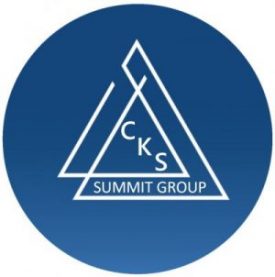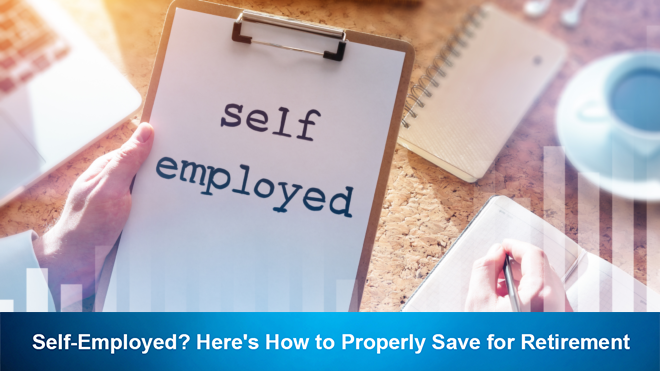Being your own boss comes with a variety of perks. However, it’s easy to get distracted from your future financial needs. Whether you’re trying to navigate an unpredictable income or pouring cash back into your business, you might find it hard to prioritize saving for retirement.
A difficult economy, market volatility, and less access to traditional pensions have heightened awareness of the need for retirement planning.
If you’re self-employed or a small business owner, you know that saving for retirement is just one of the many things you have to figure out on your own. Many people choose to be self-employed for the freedom and the potential to make unlimited income, but as the boss, maybe you put too much trust in the idea that you’ll eventually make it big and become incredibly wealthy. In which case, you forget about saving for retirement now. However, it’s always a smart move to have an alternative plan in place.

If you’re your own boss, chances are you aren’t doing enough to save for retirement.
Just over 1 in 10 of self-employed individuals in a single-person business is currently participating in a workplace retirement plan, according to data from The Pew Charitable Trusts.
In comparison, 72% of employees in larger companies utilized a 401(k) at work, the organization found.
As a self-employed individual, you really have to think carefully about your future, since you don’t have an employer sponsored retirement plan to help you prepare.
But you do have options.


This may sound like the obvious, but saving 40% of your pay (rather than the standard 30% of self-employed individuals) will give you the financial freedom you need when it comes to enjoying your golden years. With that extra 10% you can create a savings fund for retirement and other financial goals.
If saving 40% of your income simply isn’t a financially viable option for you, depending on how much you earn and how much you plan to contribute to your retirement each year, you may have several great retirement options to choose from.

Several tax favored retirement plans are available to self-employed individuals. All allow you to make tax-deductible contributions. And those contributions, along with investment earnings, grow tax deferred until you take withdrawals from the plan.
Once you’ve decided to open a retirement savings account, you’ll have to decide where to do it.
Solo 401(k)
Solo 401(k) plans are worth considering, due to their relatively high contribution limits, flexible investments and the ability to make after-tax Roth contributions.
For 2022, it’s $61,000, plus a $6,500 catch-up contribution or 100% of earned income, whichever is less. To help understand the contribution limits here, it helps to pretend you’re two people: An employer (of yourself) and an employee (also of yourself).
You can open a solo 401(k) at many online brokers. You’ll need to file paperwork with the IRS each year once you have more than $250,000 in your account.
The biggest downside with this type of plan is that you can’t use it if you have employees other than your spouse. Further, you’ll have to fill out quite a bit of paperwork to open a Solo 401(k), more so than if you had chosen a SEP IRA instead.
SEP IRA.
Contributing to a SEP IRA will decrease your tax burden, and your money will grow tax-deferred until retirement. The lesser of $61,000 in 2022 ($58,000 in 2021) or up to 25% of compensation or net self-employment earnings, with a $305,000 ($290,000 in 2021) limit on compensation that can be used to factor the contribution. Again, net self-employment income is net profit less half of your self-employment taxes paid and your SEP contribution. No catch-up contribution.
Furthermore, the SEP IRA is also more widely available, so your preferred online broker may offer it, and not the self-employed 401(k). If that’s your situation, the SEP IRA is an excellent choice.
You can open a SEP IRA at many online brokers just as you would a traditional or Roth IRA, with a few extra pieces of paperwork.
Simple IRA
A Simple IRA is best for larger businesses with up to 100 employees. Unlike the SEP IRA, the contribution burden isn’t solely on you: Employees can contribute through salary deferral. But employers are generally required to make either matching contributions to employee accounts of up to 3% of employee compensation, or fixed contributions of 2% to every eligible employee. Choosing the latter means the employee does not have to contribute to earn your contribution. The compensation limit for factoring contributions iso $305,000 in 2022 ($290,000 in 2021).
You can contribute up to $14,000 in 2022 ($13,500 in 2021), plus catch-up contribution of $3,000 if 50 or older). If you also contribute to an employer plan, the total of all contributions can’t exceed $20,500 in 2022 ($19,500 in 2021).
Defined Benefit Plan
If you’re self-employed with NO employees (and a high income), a Defined Benefit Plan may be for you.
Contributions are generally tax deductible, and distributions in retirement are taxed as income. An actuary must figure your deduction limit, which adds an administrative layer. The amount you can contribute is calculated on the benefit you’ll receive at retirement, your age and expected investment returns.
IRA and Roth IRA
Those just starting out. If you’re leaving a job to start a business, you can also roll your old 401(k) into an IRA.
With traditional IRAs, contributions are generally tax deductible and not subject to income tax until withdrawn. On the contrary, the Roth IRA allows you to put money in post-tax, making withdrawals in retirement tax free. This individual retirement arrangement offers several powerful tax benefits that make it a no-brainer for many retirement savers.
To start, you can contribute up to $6,000 per year in 2022 to a Roth — plus an extra $1,000 if you’re 50 or older.

When you’re the boss, it sometimes feels intimidating to tackle the process of retirement saving by yourself. Ultimately, you will need to do some research on your current/potential income as an entrepreneur, and then talk to one of our a retirement income advisors about which retirement savings option will allow you to save the most.
The advisors at CKS Summit Group offer options to help you set up the retirement plan that best fits your situation. Click here to set up your complimentary strategy session, or give us a call today on 586-286-5820.



